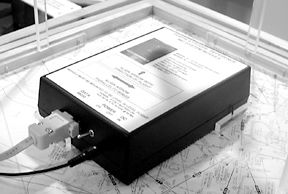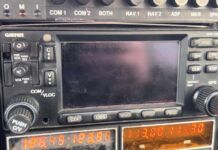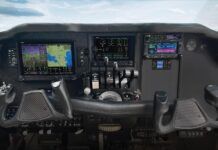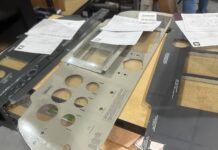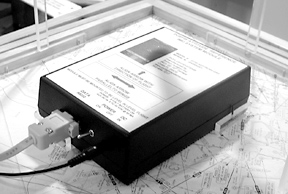
In the aviation press, we seem to endlessly debate the question of whether a pilot with average training and proficiency can hope to survive a partial-panel emergency involving loss of an attitude indicator.
And while weve reviewed the back-up options-secondary vacuum pumps and spare electric AIs-one thing that has been overlooked is the idea of a solid-state gyro of the sort that are standard equipment on the flight decks on state-of-the art airliners.
Now just such a product has arrived in the form of a clever solid-state device called a microEFIS , which outputs gyro information on a common Compaq PDA. Its not certified, of course, but our reaction to that is: who cares?
A Little Reality
Most of us recognize that a turn indicator or turn coordinator is barely adequate as back-up for an attitude indicators combined pitch-bank information. Recognizing this, FAR certification requirements for turbine and large aircraft call for two and sometimes three attitude indicators. Turbines dont even require a single turn coordinator, although the FAA insists they be retained in piston aircraft.
For about a year, Ive been flying with a back-up handheld GPS, as many of us do. It provides a sense of security in the event that the aircrafts entire electrical system goes belly-up. At least I know where I am and can find an airport. Wouldnt it be great if the same kind of technology could be applied to provide fail-safe, independent attitude information?
Thats exactly what pcflightsystems.com has done with its microEFIS system. We were pleased to see theyve enlisted Stephen Silverman of Icarus Instrument Inc. to exhibit and sell their product. Silverman has done well with such niche products as the AltAlert and NavAlert.
When we visited the EAA AirVenture show in July, I left with a pcEFIS and have been flying it ever since. First, the terminology may be confusing. The system is alternately called a microEFIS, an electronic attitude reference system and a pcEFIS. For the sake of simplicity, well call it a pcEFIS for this report.
The heart of the system is a solid-state sensor, the inertial measurement unit or IMU. The IMUs output data is displayed on a handheld computer or PDA. The IMU is really an electronic gyro and is contained in a plastic box measuring 7 by 5 by 2 inches and weighing a pound.
It must be fixed to the aircraft and thus is called a strap down sensor. Its powered by internal standard 9-volt alkaline batteries or external DC power between 8 and 32 volts so it can be plugged directly into the cigar lighter of aircraft with either 12 or 24-volt systems. The unit is shipped with the appropriate power cables.
The IMU has three solid-state accelerometers and three solid-state gyroscopes; a pair for each axis. These determine the aircrafts attitude in space and sense changes in position. This information is encoded and available as a serial digital signal. A cable connects the unit to a display through a standard serial-to-PDA cable supplied by the PDA manufacturer.
The company cleverly simplified design by choosing a common pocket PC as the display. The lightweight display can be mounted anywhere, although the yoke is an obvious location. You can strap it to your thigh or put it anywhere on your panel using Velcro or even rubber bands.
Unlike a mechanical attitude indicator, in which the instrument display and sensor (gyroscope) cannot be separated, the pcEFIS display can be moved without influencing attitude information. Pcflightsystems strongly recommends the Compaq iPAQ 3600 series with its bright color display. However, a fast Hewlett-Packard or Casio pocket PC is also satisfactory, were told.
There are two versions of this system. Bought direct from pcflightsystems.com, the system retails for $1395, which includes the gyro module and the software, plus the cabling to go from the module to the PDA. Depending on model, the Compaq iPAQs retail between $480 and $600. Icarus tells us the 3600 and 3700 series iPAQs are suitable for this device but the 3800 isnt because the proper cabling isnt available yet. (It may be at some point.)
The pcflightsystems.com version of the product includes only attitude information on the display, no navigation or GPS data is combined. The Icarus version of the system sells for $1495 and for the extra $100, you get GPS-derived waypoint data on the display, including something called stabilized groundtrack, which acts like a virtual heading indicator, using accelerometer-derived rather than slower GPS-derived heading change information, a real advantage if youre flying genuine partial panel.
Further, the Icarus version includes a round skid ball and a CDI, which the pcflightsystems.com version lacks. Icarus recently released a software version that allows running the Control Vision Anywhere moving map simultaneously with the attitude display on the Compaq. You can simply toggle back and forth between the two programs.
For $125, Icarus can supply a smart cable that converts the output of a panel-mount GPS into marine format so it can drive the GPS functions of the Icarus software, eliminating the need for portable GPS input. Icarus has also developed a customized cradle that addresses the iPAQs fundamental weakness: the flimsy cable socket at the bottom of the unit.
The Set-Up
Pcflightsystems provides the necessary software on a floppy disk and the latest versions can be downloaded from their web site into a laptop or desktop. Using Microsoft ActiveSync, the standard software accompanying most handhelds, the EFIS program is transferred from the PC to the PDA. Once the pcefis.exe program is opened, the PDA screen looks like an attitude indicator and accepts signals from the IMU. Its pretty simple. Steve Silverman loaded a Compaq iPAQ for our tests as we ran into initial problems establishing communications between the handheld iPAQ and an IBM laptop. This glitch had nothing to do with pcflightsystems.com or Icarus and was cleared up during a brief phone call to the Compaq help line.
Later, we easily updated software both from pcflightsystems.com web site, and from a floppy disk. We transferred the software through a laptop to the iPAQ without a problem and it worked fine.
The IMU is placed near the central axis of the aircraft and forward of the vertical axis. If the unit is placed behind the vertical axis, the inclinometer will move to the wrong side on skids and slips. The unit is strapped down to the aircraft floor using Velcro, but on our trials, we simply wedged it beneath the floor carpet. Arrows on the unit show the required alignment; one arrow in the direction of flight, and a two-headed arrow aligned with the wings.
While the airplane is sitting on the ground, the IMU is switched on so the sensors can stabilize. After 30 seconds, the handheld software is opened. And…thats it. In flight, the display can be realigned in straight, level, and unaccelerated flight by tapping over the word Align on the display.
This is required in tailwheel airplanes or those whose normal flight attitude is different than their posture on wheels. No other controls are available or required, except for Exit. If you like gadgets with buttons and controls, the pcEFIS will leave you bored.
The IMU and iPAQ voltages are displayed in the upper right-hand corner of the PDA screen, and a rotating bar shows the iPAQ processor is working. If powered externally, the ships voltage to the IMU is displayed. The IMU automatically switches to the 9-volt internal battery when ships voltage is lost, and continues working until below 7 volts.
The iPAQ has a self-contained rechargeable battery. Power saving features should be disabled, or the display may turn itself off, perhaps inconveniently. Its also necessary to exit all other programs for the best pcEFIS performance, unless youre using the Icarus version, which runs nicely with the Anywhere map program.
While not available at the time I picked up the unit at Oshkosh, pcflightsystems.com plans a single cable to power the PDA and IMU from a cigar lighter, thus, the system will use aircraft power and internal handheld and IMU batteries are reserved for emergencies.
Performance
We found the pcEFIS symbology initially unfamiliar, but that changed after a few hours of use. The instruction manual is terse and could be improved by graphics to show what the different symbols mean in various attitudes.
We mentioned to Craig Sellers, the design engineer, that we preferred extended wings on the aircraft symbol instead of lateral ticks. Within days we received updated software that not only colored the aircraft icon yellow to distinguish it from background lines, but the wings were extended. We fly looking at the horizon line and not the bank scale at the top of the display. Small bank angles were less obvious with stubby wings.
There are several lines near the top of the display. A long line acts like a seesaw and displays rate of bank and turn, just as a turn coordinator does. We considered this seesaw rather twitchy and sometimes distracting, although it followed the turn coordinator surprisingly well.
This line has since been shortened and moved to the bottom of the display. When we indicated we would prefer a ball to a short vertical line, the software was modified. A short horizontal line indicates vertical acceleration, but we dont yet have an adequate feel for how this helps.
Ideally, there should be a way to set-up the display as a pilot prefers and a reversion mode to bring it back to look like a standard attitude indicator. Sellers promised such revisions in the future.
Documentation doesnt fully address the sensor limitations, except to mention that the unit is not accurate at angular rates greater than 60 degrees/second. If true, that would limit its use during snap rolls, but few maneuvers short of that should tumble the pcEFIS. However, on the ground, the unit was stable through 360 degrees in all three axis.
When we tested the unit initially in the air and on the ground, we found bank angles greater than about 45 degrees and pitch angles greater than 30 degrees werent properly indicated. In each case, the horizon returned to level even as pitch or bank was maintained. After a discussion with Sellers, we returned the unit as he suspected an accelerometer was not functioning. Three days later, we had a new unit that showed improved performance.
Based upon this, we suggested an annunciator to warn if a sensor had failed and a diagnostic program incorporated into the software to test each individual gyro and accelerometer.
Flight Tests
We did an extended test ride with the pcEFIS in a Cessna 182. For the test, we fastened the PDA to our thighs with Velcro straps. The IMU was positioned under the copilots floor board, beneath the rug. We used ships power for the IMU and charged the iPAQ overnight, since we didnt have a ships power cable.
The unit initialized properly and we took off and flew turns, climbs, descents, holding patterns and a VOR approach. While there was sometimes a delay before the pcEFIS showed straight and level, we found the airplane to be perfectly controllable using the instrument exclusively. We even did unusual attitudes and power-on/off stalls.
Unfortunately, the iPAQ display blanked every few minutes, as we were using the internal iPAQ battery. Although it immediately came on again when the silver button was pressed, this was inconvenient. We attempted to reconfigure the iPAQ, but could not defeat the power saving display-off feature. We were flying on a bright overcast day with visibility 5 to 7 miles and the display had to be set on bright for the best daylight visibility. We both noted that at times, damping of the unit was not identical to standard vacuum attitude indicator or aircraft attitude, but the airplane was flyable with the pcEFIS alone. Sellers explained that his initial models were accurate in all angles of roll and pitch, but this required the IMU to be hard mounted within two degrees of true level, something thats not practical for a portable.
By adjusting tolerances, the current unit can accept up to 15 degrees of mis-mounting and still function. While accurate in straight and level, the trade off was less accuracy in other attitudes.
In our initial test, the unit did well until we were in the pattern for landing and then twice the pcEFIS showed banks opposite the actual aircraft attitude. In each case, the display corrected itself in a few seconds.
We were disheartened to see this, as after more than an hour of flying we accepted the display as a valid substitute for the mechanical AI. We broke off and flew another procedure turn and approach, varying headings more than would be typical. The pcEFIS again appeared functional.
Reentering the traffic pattern, the iPAQ suddenly went dark and could not be restarted; the battery was dead after an hour and a half. There was no iPAQ battery indication when in pcEFIS mode.
Sellers explained that peculiarities of the Compaq iPAQ, not the IMU, were the cause of some anomalies we noted. When the iPAQ battery reaches about half charge, it enters a power-saving mode to protect the stored programs. Thus, during the latter part of the test flight, when the screen would go blank, the processor was also stopping. When we pushed the button to wake up the iPAQ, it didnt know where it was and thus the initial attitude was incorrect.
Sellers has modified the software to annunciate the processor status of the iPAQ and to display voltages of the iPAQ and IMU. A forthcoming combined cable for both the iPAQ and IMU will solve the power problem. We judge if aircraft power were lost, theres a good hour of battery power left but not much more. Thus, the system should be powered from a ship source.
Conclusion
Pcflightsystems.com walks the legal tightrope in clearly advising their purchasers that this unit is not FAA certified for IFR flight and is not meant to be used as a primary flight instrument. It should only be used in an emergency.
We recommend practicing under the hood with a safety pilot or instructor. If youre not comfortable using the pcEFIS, it wont provide a safety net when you need it.
You cant turn it on after youre in an unusual attitude, therefore, the iPAQ and IMU must be kept running, not just aboard the airplane ready for use when you need it.
With these minor reservations in mind, the pcEFIS is a capable product, and thus far the only portable attitude unit available. For that reason, we think its a serious contender for real-world back-up. During the short time we used an evaluation unit, we had some problems but the product has been under continual refinement to correct these issues. Further, were confident in saying more improvements will be forthcoming.
For those flying rental aircraft, the pcEFIS is the only back-up practical but we think its useful in any aircraft as an alternative to a second attitude indicator.
Also With This Article
Click here to view “Checklist.”
Click here to view “pcEFIS Screen Symbology (Icarus).”
Click here to view “In The Works.”
Click here to view “Addresses.”
-by Ian Blair Fries
Ian Blair Fries is an AviationConsumer contributing editor and an ATP-CFII. He flies a Socata TBM 700 based in Farmingdale, New Jersey.

